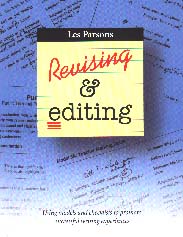| ________________ CM . . . .
Volume VIII Number 1 . . . . September 7, 2001
excerpt: Revising & Editing is a helpful and timely book which will be of use to most middle/secondary teachers and will also be of interest to educators working with adult literacy classes. Parsons has mastered the art of the short, concise, focused text (as he has previously shown with Response Journals). He has once again identified an area of interest for English language arts instructors and has selected material to address teachers' concerns. Revising & Editing offers material to assist teachers and students to deal with the improvement of their written text beyond the use of spell checking software! Parsons' book has five chapters entitled: "Drafting in the Computer Age" (a look at how the use of the computer has influenced our writing habits); "Collaboration and the Drafting Process" (how to deal with peer revision, editing, conferencing); "Revision Checklists" (a look at revising words, sentences and paragraphs); "Peer-revision Models" (overheads/handouts for teachers to use to teach students how to be helpful revisers); and, finally, "An Editing Toolkit" (dealing with usage, capitalization, punctuation). Despite this organization, however, readers should be aware that Parsons really only has two topics: revising (substituting, adding, deleting, re-ordering words, phrases, sentences, sections, and ideas) and editing (spelling, usage, clarity). The revision and editing of writing is a perennial concern for teachers. All curricula in language arts demand attention to improving writing, and writers of all ages are often loath to change their drafts. Teachers who are also writers will recognize such difficulties in their own work and would be well advised to discuss the writing process with their students. Parsons' work deals strictly with the how-to's of revision and editing, not with reasons for changing (by audience demands, for example) or with motivating reluctant writers (who would almost always like one draft to be "good enough"! Nevertheless, Revising & Editing offers a "toolkit" of useful materials for the composition teacher. It includes a glossary of terms (such as paragraph, peer editing, period, personal response), a variety of black line masters (Checklist of Words Easily Confused, Student Guideline for Generating Essay Ideas...), and models of written work for students to discuss. There is even a guideline sheet for parents, guardians or older siblings to use in assisting a student. Teachers of middle/secondary and adult students will find Revising & Editing a handy addition to their reference shelf. Recommended. Deborah L. Begoray, an associate professor of secondary English in the Faculty of Education at the University of Victoria, does extensive work assisting teachers to implement the English Language Arts curriculum.
To comment on this
title or this review, send mail to cm@umanitoba.ca.
Copyright © the Manitoba Library Association. Reproduction for personal
use is permitted only if this copyright notice is maintained. Any other
reproduction is prohibited without permission.
Published by NEXT REVIEW | TABLE OF CONTENTS
FOR THIS ISSUE - September, 2001.
AUTHORS | TITLES | MEDIA REVIEWS | PROFILES | BACK ISSUES | SEARCH | CMARCHIVE | HOME |
